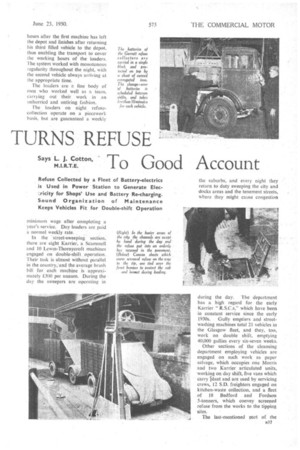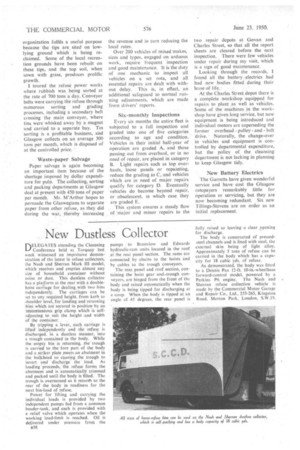GLASGOW TURNS REFUSE To Good Account
Page 42

Page 43

Page 44

If you've noticed an error in this article please click here to report it so we can fix it.
Says L. J. Cotton,
M.I.R.T.E.
Refuse Collected by a Fleet of Battery-electrics is Used in Power Station to Generate Elec. Lricity for Shops' Use and Battery Re-charging. Sound Organization of Maintenance Keeps Vehicles Fit for Double-shift Operation
THAT there is a glint of gold in every dustbin-load of refuse, was the opinion formed after visiting the cleansing department of
Glasgow Corporation. After the metal, paper and other salvageable material have been claimed from the refuse, the incombustible remainder is screened and graded for building up low ground, whilst the burnable material is used-to generate power for the fleet of -battery-electric refuse • collectors-used -by the •Corpciration.In fact, there is so much combustible ,material in rubbish that the 'refuse . , power works not only generates its own electricity, but annually feeds up to 1110,000 worth of surplus into . the external grid system.
Mr. -.Ga.viri C. M'Arthur, M.B.E., IP.; director of cleansing, has had many years experience in keeping Glasgow a tidy and wholesoMe city. His task is said to be the largest of its kind in Britain, and second only to that of his opposite number in Paris in the whole of Europe. Unlike London, and other large cities, which have separate borough organizations, the whole of Glasgow and its suburbs, including the docks areas, is under the jurisdiction of one cleansing department.
817 Miles of Streets
The work involved at Glasgow includes the Collecting, sorting and disposing of refuse from over 291,000 houses and tenements in an area of 39,725 acres, the emptying of 40,000 gullies and the sweeping and cleaning of 817 miles of streets.
Because of the density of traffic in the city, and the prevalence of tenemental property (actually four-fifths of the Glasgow population is housed in tenements), the bulk of refuse and street sweepings of these areas has to a36
be allocated to a night shift. Although this adds to road safety and .saves congestion, it is also instrumental in reducing the capital cost of vehicles and machines, but requires careful watch on maintenance, because the majority of the fleet is in operation 18 hours a day.
• The backbone of the refuse-collection fleet is comprised of 66 Garrett battery-electrics, many of which have been in operation for 20 years. Many favourable comments have been received regarding the quiet operation of the Garretts, which are all engaged on double-shift duty. A total of 131 mechanically propelled vehicles, including 12 articulated units, and a number of horse-drawn vehicles, collect an average of 1,500 tons of domestic and trade refuse ,a day in the Glasgow area. ..,1n winter, 'when the density of the refuse is higher, the
total often exceeds 2,000 tons a day.
The Garretts are operated in a four-mile radius from the Govan Garage, where a second set of batteries is always on charge for the changeover between shifts. The loaders and drivers, particularly the former, favour these vehicles because of the low loading line, which eases
their task considerably. They also praise the Dennis Paxits and Lewin Oschnersof the fleet because they
can tip the refuse direct into the rear container with the minimum of effort
There is sound organization behind the night-shift operation of these vehicles I left Govan at 10 p.m. on one of the Garretts, which three• loaders filled in two hours. To reduce noise and expedite their work, the loaders collect the refuse in wicker baskets, each man's loading rate being 18 to 20 cwt. per hour. A second Garrett drew up behind, when the first vehicle was almost tilled, and after a quick changeover of drivers the loading continued on the second maehine.
This changeover is made because one loading crew fills five vehicles-in one night, and the first driver out finishes his work after returning his second load to the depot.The second driver starts his duties two
hours after the first machine has left the depot and finishes after returning his third filled vehicle to the depot, thus enabling the transport to cover the working hours of the loaders. The system worked with monotonous regularity throughout the night, with the second vehicle always arriving at the appropriate time.
The loaders are a fine body of men who worked well as a team, carrying out their work in an unhurried and untiring fashion_ The loaders on night refusecollection operate on a piecework basis, but are guaranteed a weekly minimum wage after completing a year's service. Day loaders are paid .a normal weekly rate.
In the 'street-sweeping section, there are eight Karrier, a Scammell and 10 Lewin-Thornyeroft machines engaged on double-shift operation. Their task is almost without parallel in the country;and the average brush bill for each machine is approximately £300 per annum. During the day the sweepers are operating in the suburbs, and every night they return to duty sweeping the city and docks areas and the tenement streets, where they might cause congestion during the day. The department has a high regard for the early Karrier " R.S.C.s," which have been in constant service since the early
1930s. Gully emptiers and streetwashing machines total 21 vehicles in the Glasgow fleet, and they, too, work on double shift, emptying 40,000 gullies every six-seven weeks.
Other sections of the cleansing department employing vehicles are engaged on such work as paper salvage, which occupies one Morris and two Karrier articulated units, working on day shift, five vans which carry Plant and are used by servicing crews, 12 S.D. freighters engaged on kitchen-waste collection, and a fleet of 18 13edford and Fordson 5-tonners, which convey screened refuse from the works to the tipping ' sites.
The last-mentioned Dart of the K37 organization fulfils a useful purpose because the tips are sited on lowlying ground which is being reclaimed. Some of the local recreation grounds have been rebuilt on these tips, and the top soil, when sown with grass, produces prolific growth.
1 toured the refuse power works where rubbish was being sorted at the rate of 700 tons a day. Conveyor belts were carrying the refuse through numerous sorting and grading processes, including a secondary belt crossing the main conveyor, where tins were whisked away by a magnet and " carried to a separate bay. Tin sorting is a profitable business, and Glasgow collects on an average 300 tons per month, which is disposed of at the controlled price. '
Waste-paper Salvage
Paper salvage is again becoming an important item because of the shortage imposed by dollar expenditure for pulp. The collecting, sorting and packing departments at Glasgow deal at present with 450 tons of paper per month. Mr. M'Arthur hopes to persuade the Glaswegians to separate paper from other refuse, as they did during the war, thereby increasing the revenue and in turn reducing the local rates.
Over 200 vehicles of mixed'makes, sizes and types, engaged on arduous work, require frequent 'inspection and good maintenance. It is the duty of one mechanic to inspect all vehicles on a set rota, and all essential repairs are dealt with without delay. This is, in effect, an additional safeguard to normal running adjustments, which are made from drivers' reports.
Six-monthly Inspections Every six months the entire fleet is subjected to a full inspection and graded into one of five categories according to age and condition. Vehicles in their initial half-year of operation are graded A, and those passing out from overhaul, or in no need of repair, are placed in category B. Light repairs such as top overhauls, loose panels or repainting, reduce the grading to C, and vehicles which are in need of major repairs qualify for category D. Eventually vehicles do become beyond repair, or obsolescent, in which case they are graded E.
This system ensures a steady flow of ,major and minor repairs to the
two repair depots at Govan and Charles Street, so that all the report sheets are cleared before the next inspection. There were few vehicles under repair during my visit, which is a sign of good maintenance.
Looking through the records, I found all the battery .electrics had had new bodies fitted during their
leaseof life.
At the Charles Street depot there is a complete workshop equipped for repairs to plant as well as vehicles. Some of the machines in the workshop have given long service, but new equipment is being introduced and individual motors are superseding the former overhead pulley and belt drive. ' Naturally, the change-over in vehicles and equipment is controlled by departmental expenditure, but the policy of the cleansing department is not lacking in planning to keep Glasgow tidy.
• New Battery Electrics
The Garretts have given wonderful service and have cost the Glasgow ratepayers remarkably little for operation or servicing, but they are now becoming redundant. Six new Tillings-Stevens are on order as an initial replacement.












































































